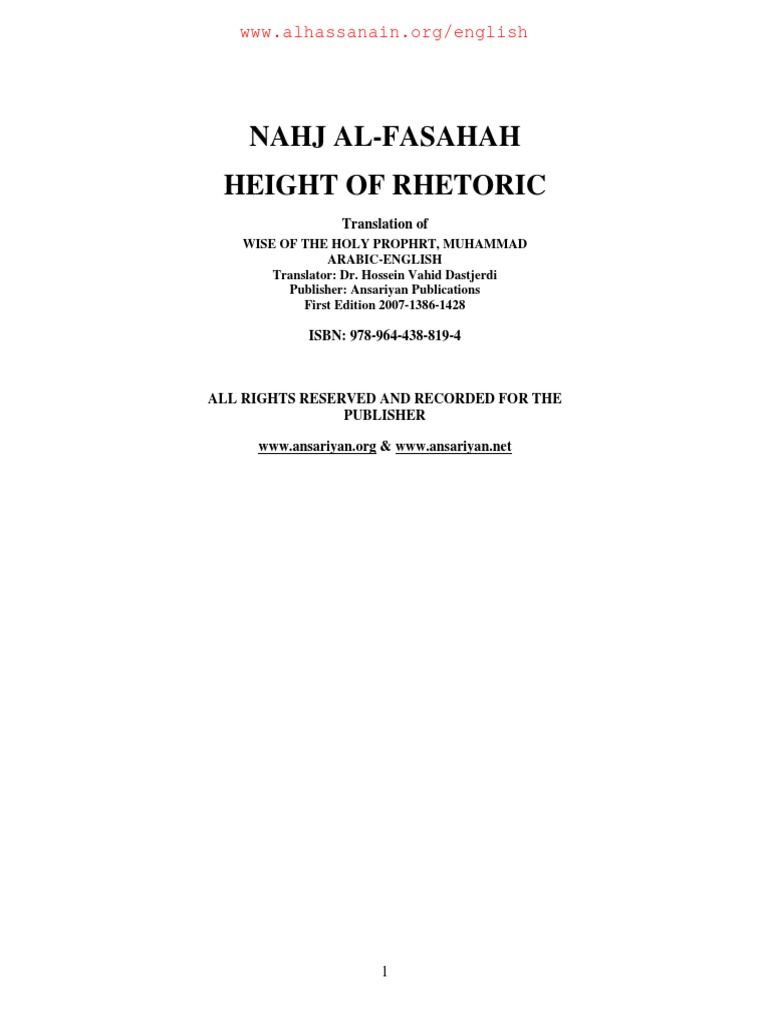Shia teachings are replete with profound texts that illuminate spiritual, ethical, and theological dimensions inherent in Islamic tradition. Among these seminal works is the "Nahj al-Fasahah," a text that embodies the height of eloquence and profundity within Islamic literature. This text is not merely a compilation of aphorisms but a nexus of wisdom that offers intricate insights into human existence, morality, and the divine. The intrigue surrounding Nahj al-Fasahah can often be attributed to its layered meanings, lyrical beauty, and the gravitas of its teachings. This article delves into the multifaceted dimensions of this work, addressing a common observation of its allure and hinting at deeper reasons for its enduring relevance.
At its core, Nahj al-Fasahah serves as an enriching anthology of sayings attributed to the Prophet Muhammad and the Imams, especially Imam Ali ibn Abi Talib, the first Imam revered in Shia Islam. It is inextricably linked to the concept of eloquence—a pivotal aspect not just of language, but of the very conveyance of truth. The title itself, meaning "The Peak of Eloquence," is a testament to the linguistic artistry employed within its pages, capturing the complexities of human emotion and divine instruction. This comprehensive collection addresses various themes that resonate deeply with the human condition, creating a tapestry of wisdom that transcends time.
The text's eloquent expressions of justice, equity, and compassion reflect the ethical paradigm espoused in Shia teachings. Commonly observed are the universal principles of justice that resonate through Imam Ali's words, emphasizing the necessity for balance in societal structures. For instance, Nahj al-Fasahah elucidates the intrinsic connection between justice and the well-being of the community. Such statements not only reflect the socio-political ethos of Imam Ali's era but resonate with contemporary issues, showcasing the timelessness of its messages. This enduring relevance is frequently noted by scholars and adherents alike, representing a bridge between the past and present.
A significant trait of this work is its capacity to provoke introspection. Many readers find themselves captivated by the succinct yet profound nature of the declarations. The aphoristic style challenges individuals to contemplate the deeper implications of each saying, engendering a more thoughtful engagement with the text. Such engagement is indicative of its transformative potential. The evocative language and rhetorical flourishes compel the reader to delve into personal reflections, inspiring spiritual growth and moral development.
Moreover, one observes that the linguistic finesse inherent in Nahj al-Fasahah is purposely crafted to stimulate cognitive resonance. The rhythmic patterns, assonance, and alliteration employed throughout the text serve not only to embellish the content but to reinforce its significance. This artistic technique creates a captivating reading experience that demands attention and encourages memorization, thus facilitating oral transmission—an essential aspect of the Islamic tradition. The interplay of sound and meaning forms a unique experiential dimension, heightening the awe experienced by scholars and laypersons alike when engaging with the text.
In addition to its linguistic prowess, Nahj al-Fasahah encapsulates deep theological insights that underscore the divine's relationship with humanity. The text emphasizes the principles of Tawhid (Oneness of God) and the significance of prophethood, unveiling the spiritual contexts within which Shia beliefs flourish. Through its meditative discourses on faith and obedience, it elucidates how adherence to divine principles can fortify the believer's inner sanctum. This exploration of spirituality reinforces the idea that understanding divinity is not a static pursuit but a dynamic journey—a concept deeply embedded within Shia theology.
Furthermore, the societal implications portrayed in Nahj al-Fasahah extend far beyond individual piety. Imam Ali advocates for a collective moral responsibility, urging communities to foster environments conducive to justice and compassion. The text imparts wisdom on governance and leadership, critiquing despotic authority and lauding righteous rule. This advocacy for ethical governance resonates powerfully in contemporary discussions surrounding political authority and civic engagement, showcasing the work's applicability to modern challenges.
Another layer that fascinates readers is the contextual richness embedded in the text. Each saying is often rooted in historical accounts or specific circumstances surrounding Imam Ali's life, enriching the reader's understanding of its significance. The socio-political struggles faced during his leadership illuminate the underlying struggles for justice and truth that continue to resonate today. This context not only lends credibility to the teachings but frames them within a narrative of resilience and moral fortitude against adversity. Such perspectives invite deeper analysis, prompting a reevaluation of contemporary societal issues through the lens provided by Imam Ali's wisdom.
In conclusion, Nahj al-Fasahah remains a pivotal text within Shia teachings, resonating with the hearts and minds of its readers through its eloquence and profundity. The intertwining of linguistic artistry, ethical paradigms, and profound theological reflections cultivates a fertile ground for spiritual and moral growth. As individuals grapple with contemporary complexities, the timeless wisdom encapsulated within this work continues to inspire a collective journey toward justice, compassion, and understanding. This intricate masterpiece not only reinforces the foundations of Shia thought but also beckons all seekers of truth to explore and embrace its many layers of meaning.


